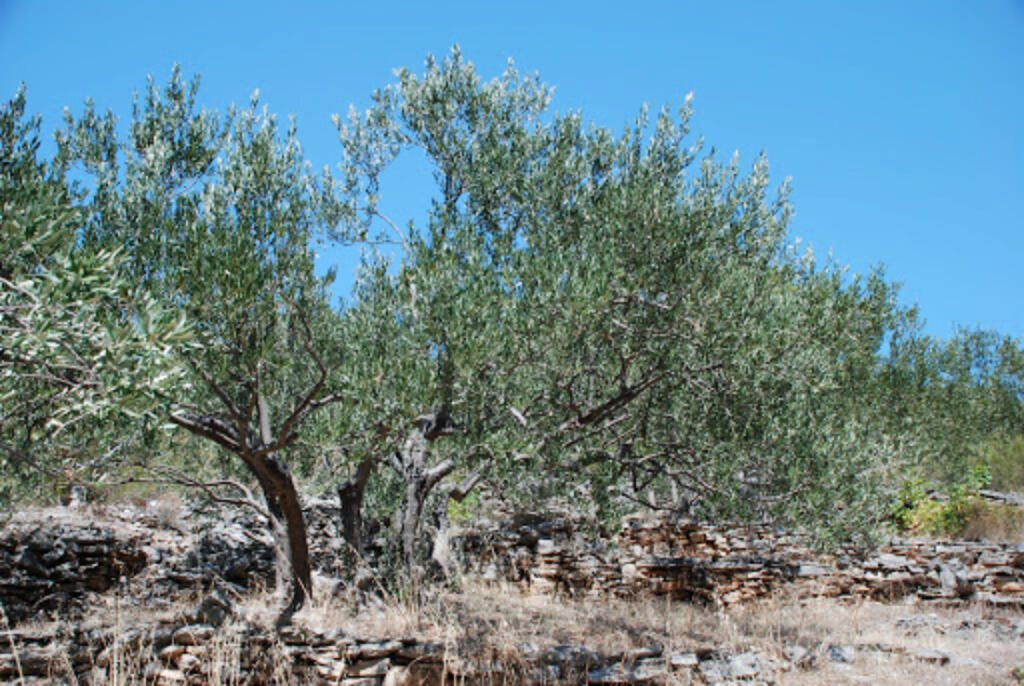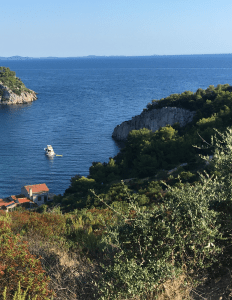Olives of the Mediterranean
A field of olive trees.
Meandering between the parcels of land are walls of loosely-stacked stones, dividing the trees among neighbors. From a high vantage point, the walls are hidden beneath the trees’ leaves, slim and dappled with sunlight, and in such abundance that they form a sea of their own in the field. The branches that hold them may seem fragile, but they grow from trunks that have weathered hundreds—if not thousands—of years. The trunks widen at the base, forming a kind of enclosure at the heart of the tree, where one might have room to step inside and see from the tree’s point of view.

This is a typical sight on the Dalmatian coast of Croatia, where every fall villagers follow worn trails to their respective parcels of land. In this region, olive trees often grow on sloped and ragged land, found all over the rocky and hilled islands of Dalmatia. As soon as the olives begin to fall from the branches, the time has come to collect them, since the longer they sit apart from the tree, the more they will sour. The work can be tedious, especially since most of the farmers are older—a problem that holds true across much of the Mediterranean. Spread out in a wide international diaspora, younger relatives are rarely around during this time of year to help and only the older population remains to tend to the olive trees.
After gathering thousands of kilos of olives, the next destination is the olive press. Green and purple olives tumble into the machine, where they are compressed and out flows slick, smooth green oil in waves. The oil fills large bottles, encased in woven coverings, and stored away in cellars, to be cooked with and shared, or sold and shipped away. Those who do not participate in the industry make only enough oil for themselves, their families, and close friends and relatives. A gift of home-grown oil is a sign of great gratitude, knowing the care and effort that goes into making it.
And the gift is always appreciated since olive oil is the base of virtually every dish in the region. The Mediterranean basin produces around 90% of the olives in the world and also consumes the vast majority of them, making olive trees a fundamental part of not only the landscape but also the regional food. As the meeting point of cultures from three continents, the Mediterranean basin has allowed a wide variety of olive oil-based foods to flourish over the centuries, ranging from grilled fish sprinkled with olive oil using a branch of rosemary to soparnik to simple pasta with olive oil, garlic, and parsley.
More recently, as environmental issues have come to the fore, the region is learning to take measures to protect the olives and their traditions. Fortunately, olive trees are relatively stable and capable of growing on their own in the wild; an estimated 70% of the world’s olive orchards are solely grown on rainwater, without any irrigation system.
However, the lack of farmers in the younger generation endangers the tradition of making olive oil, and already many have accepted that their fields will become wild and overgrown as they can no longer maintain them. Although olives are often praised for their great health benefits, recent literature and films have aimed to go beyond science by showing the cultural traditions surrounding the over 3000-year-old cultivation of olives and encourage the preservation of these traditions.
Unlike most fruits, which grow from the pit, olives grow from other olive trees. Root cuttings are the common method of propagation. Much like the traditions surrounding them, olives grow from the root, from their very beginnings, before they can stretch their own branches into the field. And like the ancient trunks, every effort is being made to help the traditions of olives of the Mediterranean continue for many centuries more.

